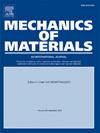基于神经网络和遗传算法的梯度塑性模型预测纳米压痕的拉伸行为
IF 3.4
3区 材料科学
Q2 MATERIALS SCIENCE, MULTIDISCIPLINARY
引用次数: 0
摘要
传统的j2流塑性理论不能解释尺寸依赖行为,限制了其在微观尺度上准确描述材料力学性能的能力。相反,应变梯度塑性理论包含应变梯度效应,使其更适合捕捉材料纳米压痕中观察到的压痕尺寸效应。本文采用传统的基于机制的应变梯度(CMSG)模型和小应变假设来近似有限变形的压痕问题。为了从纳米压痕实验中提取材料参数,以CMSG塑性模型为研究对象,提出了一种将长短期记忆(LSTM)神经网络模型与遗传算法相结合的反演方法。采用CMSG塑性模型进行有限元模拟,生成神经网络模型的训练和验证数据,并结合遗传算法确定材料参数。将模拟结果与纯铜的纳米压痕和单轴拉伸试验结果进行对比,验证了该方法的有效性。结果表明,实验数据与模拟结果具有较强的相关性,从而肯定了反演方法在反演CMSG塑性模型应变梯度参数方面的准确性。该研究还强调了压痕尺寸效应在微尺度材料行为中的关键作用,为小尺度材料的机械性能提供了更深入的见解。此外,用该方法测定退火铜膜材料参数的结果进一步说明了该方法的普遍性。本文章由计算机程序翻译,如有差异,请以英文原文为准。

Predicting tensile behavior from nanoindentation using gradient plasticity model with neural network and genetic algorithm
The conventional J2-flow theory of plasticity fails to account for size-dependent behavior, limiting its ability to describe the mechanical properties of materials at the microscale accurately. In contrast, the strain gradient plasticity theory incorporates strain gradient effect, making it more suitable for capturing the indentation size effect observed in the nanoindentation of materials. This study employs the conventional theory of mechanism-based strain gradient (CMSG) model with a small strain assumption to approximate the indentation problem involving finite deformation. To extract material parameters from nanoindentation experiments, specifically focusing on the CMSG plasticity model, this study introduces an inversion method that integrates a Long Short-Term Memory (LSTM) neural network model with a genetic algorithm. Finite element simulations using the CMSG plasticity model were employed to generate training and validation data for the neural network model, which was then combined with a genetic algorithm for material parameters determination. The method was validated through comparing the simulations with the experimental results from nanoindentation and uniaxial tensile tests on pure copper. The results demonstrate a strong correlation between the experimental data and the simulations, thereby affirming the accuracy of the inversion approach in retrieving strain gradient parameters of the CMSG plasticity model. The study also highlights the critical role of the indentation size effect in microscale material behavior, offering deeper insights into mechanical properties at small scales. Moreover, the results of material parameters of annealed copper films determined by this method further illustrate the universality of the proposed approach.
求助全文
通过发布文献求助,成功后即可免费获取论文全文。
去求助
来源期刊

Mechanics of Materials
工程技术-材料科学:综合
CiteScore
7.60
自引率
5.10%
发文量
243
审稿时长
46 days
期刊介绍:
Mechanics of Materials is a forum for original scientific research on the flow, fracture, and general constitutive behavior of geophysical, geotechnical and technological materials, with balanced coverage of advanced technological and natural materials, with balanced coverage of theoretical, experimental, and field investigations. Of special concern are macroscopic predictions based on microscopic models, identification of microscopic structures from limited overall macroscopic data, experimental and field results that lead to fundamental understanding of the behavior of materials, and coordinated experimental and analytical investigations that culminate in theories with predictive quality.
 求助内容:
求助内容: 应助结果提醒方式:
应助结果提醒方式:


